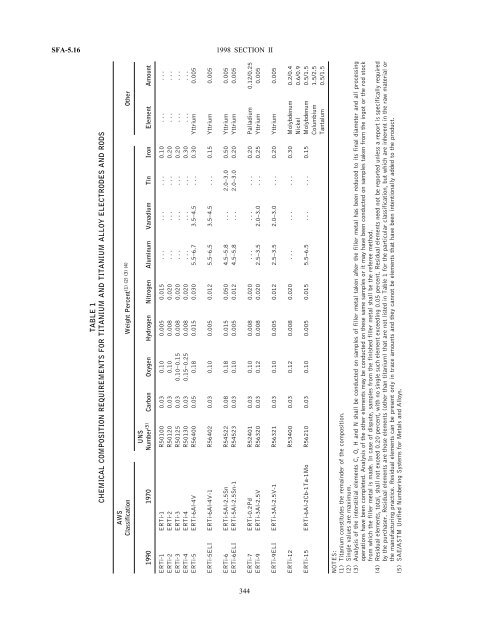SFA-5.16
SFA-5.16
SFA-5.16
You also want an ePaper? Increase the reach of your titles
YUMPU automatically turns print PDFs into web optimized ePapers that Google loves.
<strong>SFA</strong>-<strong>5.16</strong> 1998 SECTION II<br />
TABLE 1<br />
CHEMICAL COMPOSITION REQUIREMENTS FOR TITANIUM AND TITANIUM ALLOY ELECTRODES AND RODS<br />
AWS<br />
Classification Weight Percent (1) (2) (3) (4) Other<br />
UNS<br />
1990 1970 Number (5) Carbon Oxygen Hydrogen Nitrogen Aluminum Vanadium Tin Iron Element Amount<br />
ERTi-1 ERTi-1 R50100 0.03 0.10 0.005 0.015 . . . . . . . . . 0.10 . . . . . .<br />
ERTi-2 ERTi-2 R50120 0.03 0.10 0.008 0.020 . . . . . . . . . 0.20 . . . . . .<br />
ERTi-3 ERTi-3 R50125 0.03 0.10–0.15 0.008 0.020 . . . . . . . . . 0.20 . . . . . .<br />
ERTi-4 ERTi-4 R50130 0.03 0.15–0.25 0.008 0.020 . . . . . . . . . 0.30 . . . . . .<br />
ERTi-5 ERTi-6Al-4V R56400 0.05 0.18 0.015 0.030 5.5–6.7 3.5–4.5 . . . 0.30 Yttrium 0.005<br />
ERTi-5ELI ERTi-6Al-4V-1 R56402 0.03 0.10 0.005 0.012 5.5–6.5 3.5–4.5 . . . 0.15 Yttrium 0.005<br />
ERTi-6 ERTi-5Al-2.5Sn R54522 0.08 0.18 0.015 0.050 4.5–5.8 . . . 2.0–3.0 0.50 Yttrium 0.005<br />
ERTi-6ELI ERTi-5Al-2.5Sn-1 R54523 0.03 0.10 0.005 0.012 4.5–5.8 . . . 2.0–3.0 0.20 Yttrium 0.005<br />
ERTi-7 ERTi-0.2Pd R52401 0.03 0.10 0.008 0.020 . . . . . . . . . 0.20 Palladium 0.12/0.25<br />
ERTi-9 ERTi-3Al-2.5V R56320 0.03 0.12 0.008 0.020 2.5–3.5 2.0–3.0 . . . 0.25 Yttrium 0.005<br />
344<br />
ERTi-9ELI ERTi-3Al-2.5V-1 R56321 0.03 0.10 0.005 0.012 2.5–3.5 2.0–3.0 . . . 0.20 Yttrium 0.005<br />
ERTi-12 R53400 0.03 0.12 0.008 0.020 . . . . . . . . . 0.30 Molybdenum 0.2/0.4<br />
Nickel 0.6/0.9<br />
ERTi-15 ERTi-6Al-2Cb-1Ta-1Mo R56210 0.03 0.10 0.005 0.015 5.5–6.5 . . . . . . 0.15 Molybdenum 0.5/1.5<br />
Columbium 1.5/2.5<br />
Tantalum 0.5/1.5<br />
NOTES:<br />
(1) Titanium constitutes the remainder of the composition.<br />
(2) Single values are maximum.<br />
(3) Analysis of the interstitial elements C, O, H and N shall be conducted on samples of filler metal taken after the filler metal has been reduced to its final diameter and all processing<br />
operations have been completed. Analysis of the other elements may be conducted on these same samples or it may have been conducted on samples taken from the ingot or the rod stock<br />
from which the filler metal is made. In case of dispute, samples from the finished filler metal shall be the referee method.<br />
(4) Residual elements, total, shall not exceed 0.20 percent, with no single such element exceeding 0.05 percent. Residual elements need not be reported unless a report is specifically required<br />
by the purchaser. Residual elements are those elements (other than titanium) that are not listed in Table 1 for the particular classification, but which are inherent in the raw material or<br />
the manufacturing practice. Residual elements can be present only in trace amounts and they cannot be elements that have been intentionally added to the product.<br />
(5) SAE/ASTM Unified Numbering Systems for Metals and Alloys.
















